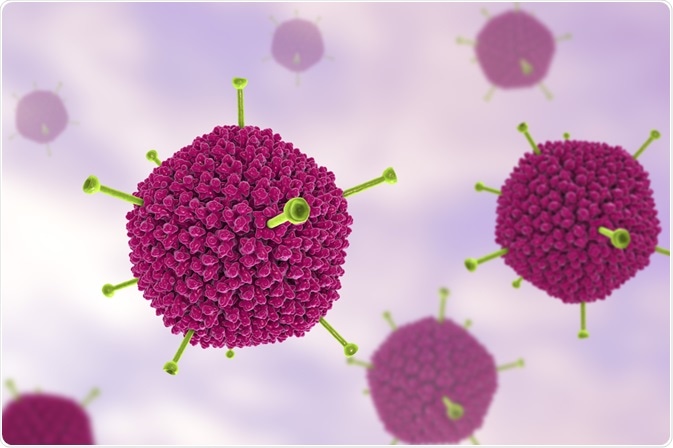What is an adeno-associated virus?
Adeno-associated virus (AAV) is a small nonpathogenic virus that lacks an envelope, and its genome is made up of linear single-stranded DNA. The AAV genome consists of two open reading frames (ORFs) which are flanked by the 145-nucleotide inverted terminal repeats (ITRs).

Image Credit: Kateryna Kon/Shutterstock.com
There are 12 human serotypes of AAV. In the absence of a helper virus, AAV-2 (serotype 2) can insert its genome into chromosome 19q13.4; this is the only example where a virus becomes latent by integrating at a specific region of the mammalian genome.
Gene therapy; curing the incurable?
When the link between DNA and inheritance/disease was made, the question of whether mutated genes can be replaced by healthy genes to cure diseases began to be discussed.
Recent advances in DNA sequencing technologies has meant that it has now become much easier and cheaper to sequence the human genome, and thus identify the potential gene(s) which are associated with certain diseases.
For diseases that are caused by changes in one gene, the use of gene therapy as a potential treatment or cure seems possible. However, the challenge is how to safely deliver an additional copy of a gene (the transgene) safely into patients.
What makes AAV an ideal gene therapy vector?
AAV has both lytic and lysogenic/latent life cycles. The presence of a helper virus, either adenovirus or herpesvirus, is required for AAV to enter the lytic life cycle; here, once AAV infects the target cell its DNA is replicated, packaged into new AAV particles and then released from the infected cell by causing it to lyse.
In the absence of a helper virus, AAV enters the lysogenic or latent life cycle, where its DNA integrates into the host cell chromosome. What makes AAV-2 unique, as mentioned above, is that it can integrate into a specific region of the human chromosome, 19q13.4, also known as AAVS1.
Studies using tissue culture have suggested that AAVS1 is a safe site for transgenes to be inserted. Therefore, having this specific integration is an ideal feature for a viral vector, as it reduces the risk of the inserted transgene unintentionally disrupting the function of another gene.
Other aspects of AAV that makes it appealing as a viral vector is that AAV is not generally a pathogen in humans and that it can persist; this means that AAV is less likely to cause problems for the patients and that the added gene will not be quickly removed.
How can AAV be used in gene therapy?
Research is being carried out to investigate whether AAV can be modified to be used as a vector for gene therapy; i.e. a gene of interest can be inserted in between the ITRs of the AAV genome, which can then become circular and packaged into recombinant AAV (rAAV) particles that can deliver the gene of interest/transgene to the AAVS1.
There are, of course, factors that need to be considered when rAAV vectors are being designed. An important consideration is the size of the target transgene; generally, it is thought that up to 5,000 bases (5kb) can be packaged into the rAAV particle, therefore rAAV may not be suitable for genes which are larger than 5kb.
It is possible, however, to design overlapping rAAV vectors in cases where the gene of interest is too large for one rAAV particle.
As mentioned above, AAV has a single-stranded DNA genome, but the transgene needs to be double-stranded once integrated into the chromosome. This means that when the rAAV delivers the transgene into the nucleus it must be converted to double-stranded DNA, which is considered to be the rate-limiting step in transgene expression.
One alternative method that can overcome this rate-limiting step is designing self-complementary rAAV particles so that each DNA strand of the transgene is carried by an rAAV.
These self-complementary single-stranded transgenes can then combine to form the double-stranded transgene at AAVS1. While this does shorten the time required for the transgene to be expressed, it has been found that genes larger than 3.3kb cannot be used to create complementary rAAV particles.
Clinical trials using rAAV as a gene therapy vector have used various methods to deliver the rAAV; these include systemic delivery and intramuscular delivery.
Systemic delivery is used to target the transgene at the liver in trials where the desire is to provide a replacement for a defective gene, while intramuscular delivery effectively turns the muscle into production sites for the transgene product.
Further Reading
Last Updated: Mar 26, 2020